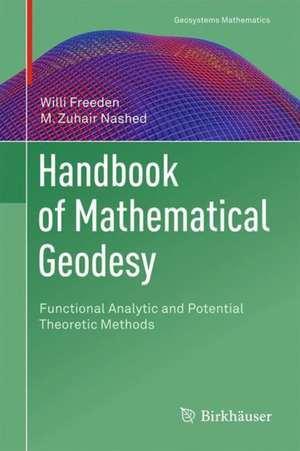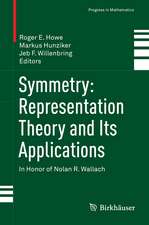Handbook of Mathematical Geodesy: Functional Analytic and Potential Theoretic Methods: Geosystems Mathematics
Editat de Willi Freeden, M. Zuhair Nasheden Limba Engleză Hardback – 22 iun 2018
| Toate formatele și edițiile | Preț | Express |
|---|---|---|
| Paperback (1) | 1138.48 lei 43-57 zile | |
| Springer International Publishing – 22 dec 2018 | 1138.48 lei 43-57 zile | |
| Hardback (1) | 1145.14 lei 43-57 zile | |
| Springer International Publishing – 22 iun 2018 | 1145.14 lei 43-57 zile |
Preț: 1145.14 lei
Preț vechi: 1396.51 lei
-18% Nou
Puncte Express: 1718
Preț estimativ în valută:
219.13€ • 229.36$ • 182.38£
219.13€ • 229.36$ • 182.38£
Carte tipărită la comandă
Livrare economică 31 martie-14 aprilie
Preluare comenzi: 021 569.72.76
Specificații
ISBN-13: 9783319571799
ISBN-10: 3319571796
Pagini: 876
Ilustrații: XIV, 932 p. 155 illus., 76 illus. in color.
Dimensiuni: 155 x 235 mm
Greutate: 1.49 kg
Ediția:1st ed. 2018
Editura: Springer International Publishing
Colecția Birkhäuser
Seria Geosystems Mathematics
Locul publicării:Cham, Switzerland
ISBN-10: 3319571796
Pagini: 876
Ilustrații: XIV, 932 p. 155 illus., 76 illus. in color.
Dimensiuni: 155 x 235 mm
Greutate: 1.49 kg
Ediția:1st ed. 2018
Editura: Springer International Publishing
Colecția Birkhäuser
Seria Geosystems Mathematics
Locul publicării:Cham, Switzerland
Cuprins
Introduction.- Gauss as Scientific Mediator between Mathematics and Geodesy from the Past to the Present.- An Overview on Tools from Functional Analysis.- Operator-Theoretic and Regularization Approaches to Ill-Posed Problems.- Geodetic Observables and Their Mathematical Treatment in Multiscale Framework.- The Analysis of Geodetic Boundary Value Problem: State and Perspectives.- Oblique Stochastic Boundary Value Problem.- About the Importance of the Runge-Walsh Concept for Gravitational Field Determination.- Geomathematical Advances in Satellite Gravity Gradiometry.- Parameter Choices for Fast Harmonic Spline Approximation.- Gravimetry as an Ill-Posed Problem in Mathematical Geodesy.- Gravimetry and Exploration.- On the Non-Uniqueness of Gravitational and Magnetic Field Data Inversion.- Spherical Harmonics Based Special Function Systems and Constructive Approximation Methods.- Spherical Potential Theory: Tools and Applications.- A combination of Downward Continuation and LocalApproximation for Harmonic Potentials.- Joint Inversion of Multiple Observation.
Recenzii
“The Handbook of Mathematical Geodesy presents for the mathematicians a wealth of applications and for the geodesists a solid embedding of the fundamental concepts of physical geodesy into approximation theory.” (Karl-Rudolf Koch, Journal of Geodesy, Vol. 93, 2019)
“The Handbook of Mathematical Geodesy presents a remarkable achievement. The book bridges the gap between the abstract work of the mathematicians and the practically oriented measurements of the geodesists. … the book is broadly planned, and it presents the present state of knowledge.” (Karl-Rudolf Koch, International Journal on Geomathematics GEM, Vol. 10, 2019)
“The Handbook of Mathematical Geodesy presents a remarkable achievement. The book bridges the gap between the abstract work of the mathematicians and the practically oriented measurements of the geodesists. … the book is broadly planned, and it presents the present state of knowledge.” (Karl-Rudolf Koch, International Journal on Geomathematics GEM, Vol. 10, 2019)
Notă biografică
Willi Freeden is Professor of Geomathematics at the Technical University of Kaiserslautern, Germany
Zuhair Nahed is Professor at the University of Central Florida, Orlando, USA
Textul de pe ultima copertă
Written by leading experts, this book provides a clear and comprehensive survey of the “status quo” of the interrelating process and cross-fertilization of structures and methods in mathematical geodesy. Starting with a foundation of functional analysis, potential theory, constructive approximation, special function theory, and inverse problems, readers are subsequently introduced to today’s least squares approximation, spherical harmonics reflected spline and wavelet concepts, boundary value problems, Runge-Walsh framework, geodetic observables, geoidal modeling, ill-posed problems and regularizations, inverse gravimetry, and satellite gravity gradiometry. All chapters are self-contained and can be studied individually, making the book an ideal resource for both graduate students and active researchers who want to acquaint themselves with the mathematical aspects of modern geodesy.
Caracteristici
Shows how modern mathematics acts as a key technology in today’s geodesy Bridges “real world” observational as well as satellite techniques and “virtual world” modeling as well as simulation Comprises high-level contributions from worldwide recognized researchers in mathematics and geodesy


















